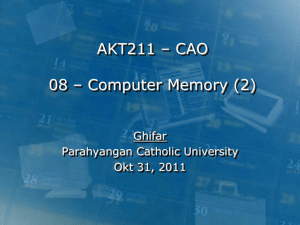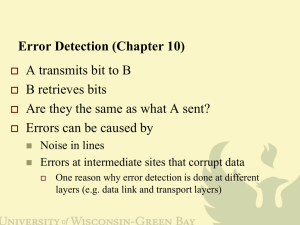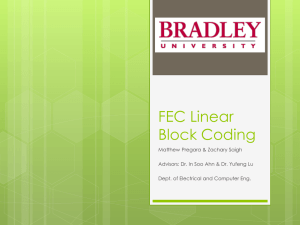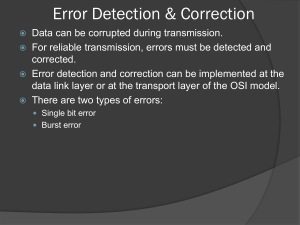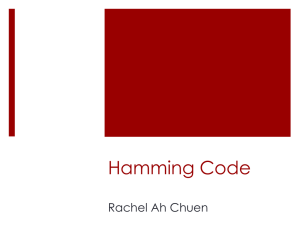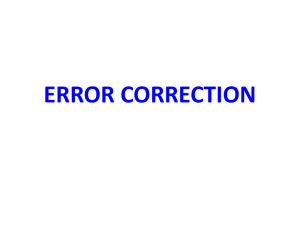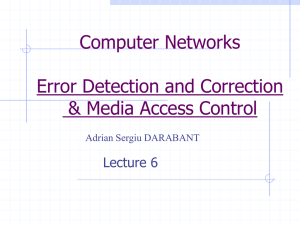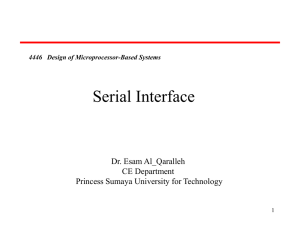Chapter 6 - William Stallings, Data and Computer Communications
advertisement
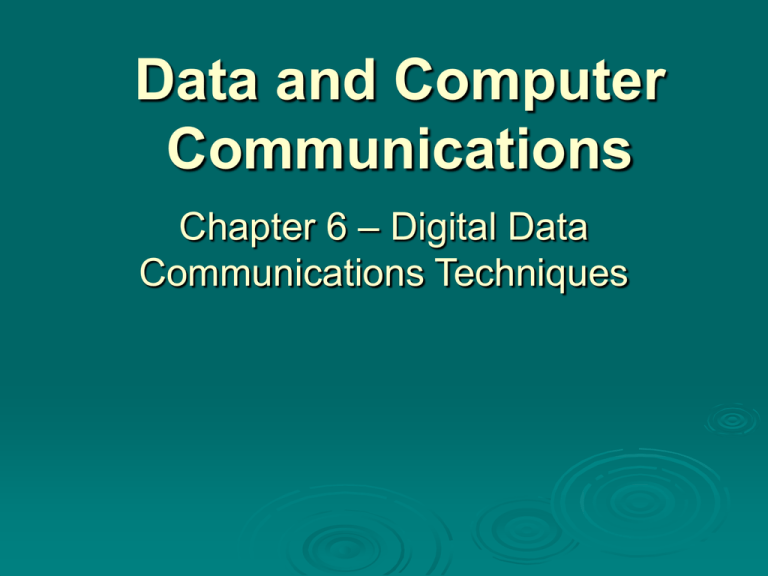
Data and Computer Communications Chapter 6 – Digital Data Communications Techniques Asynchronous and Synchronous Transmission timing problems require a mechanism to synchronize the transmitter and receiver receiver samples stream at bit intervals if clocks not aligned, drifting will sample at wrong time after sufficient bits are sent two techniques to synchronize asynchronous transmission synchronous transmission Asynchronous Transmission Asynchronous - Behavior simple cheap overhead of 2 or 3 bits per char (~20%) good for data with large gaps (keyboard) Synchronous Transmission block of data transmitted, sent as a frame clocks must be synchronized need to indicate start and end of block can use separate clock line or embed clock signal in data use preamble and post-amble more efficient (lower overhead) than asynchronous Types of Error an error occurs when a bit is altered between transmission and reception single bit errors only one bit altered caused by white noise burst errors contiguous sequence of B bits in which first, last and any number of intermediate bits are in error caused by impulse noise or by fading in wireless effect is greater at higher data rates Error Detection will have errors detect using error-detecting code added by transmitter recalculated and checked by receiver still chance of undetected error parity parity bit set so frame has even number of ones (even parity) or odd number of ones (odd parity) even number of bit errors goes undetected Error Detection Process Error Detection Pb= Probability a bit is received in error, Bit Error Rate (BER) P1= Probability a frame is received with no error P2= Probability a frame is received with undetected error F = number of bits / frame Then, P1= (1- Pb)F , P2= (1- P1) Error Detection # ISDN has 64 Kbps channel, 1 frame with undetected error per day is expected, (1 frame = 1000 bits), Calculate the number of Frames / day and P2. actual Pb= 10-6, can we achieve the above P2? If Cyclic Redundancy Check one of most common and powerful checks for block of k bits, transmitter generates an n-k bit frame check sequence (FCS) Transmits n bits which is exactly divisible by some number receiver divides frame by that number if no remainder, assume no error for math, see Stallings chapter 6 Cyclic Redundancy Check Basis: Modulo-2 arithmetic (X-or for + or -) Message, M = 1010001101 Pattern, P = 110101 (MSB & LSB = ‘1’) FCS = ? (5 bits) (01110) Multiply the Message by 25, then divide by the Pattern. Remainder is added with the Message and transmitted. P is one bit longer than FCS. Cyclic Redundancy Check Selection of polynomial P: - Should not be divisible by X - Should be divisible by X+1 Benefits: - Detects all burst errors that affect odd number of bits - Detects all burst errors of length less than or equal to degree of the polynomial Cyclic Redundancy Check - Detects, with high probability, all burst errors of length greater than the degree of the polynomial Cyclic Redundancy Check # CRC-12 (X12+ X11+X3+X+1) Degree: 12 Detects all burst errors that affects odd number of bits, Detects all burst errors of length less than or equal to 12, Detects (99.97 percent of) all burst errors of length more than or equal to 12. Cyclic Redundancy Check Digital Logic Implementation: Message, M = 1010001101 = X9+ X7+X3+X2+1, Pattern, P = 110101 = Poly.? Register length = FCS Presence of a gate corresponds to a term in polynomial P, excluding 1 (X0) and Xn-k Error Correction correction of detected errors usually requires correct data block to be retransmitted not appropriate for wireless applications bit error rate is high causing lots of retransmissions when propagation delay long (satellite) compared with frame transmission time, resulting in retransmission of frame in error plus many subsequent frames instead need to correct errors on basis of bits received error correction provides this Error Correction Process Error Correction 2-dimensional Parity: “Data is arranged in 2-dimensional array and parity bit is added for each row and column” PV 0 1 1 00 “Detects and Corrects all single 10100 bit errors” 1 1 1 01 “Detects all odd number of 01111 bit errors and some even 0 1 0 1 0 PH number of bit errors” How Error Correction Works adds redundancy to transmitted message can deduce original despite some errors e.g. block error correction code map k bit input onto an n bit codeword each distinctly different if get error, assume codeword sent was closest to that received for math, see Stallings chapter 6 Much reduced effective data rate Block Code Principles Hamming distance = difference in # of bits, p = 011011, q = 110001, d (p,q) = ? Data Code 00 00000 01 00111 10 11001 11 11110 # Find the distance between all the valid codes (in pairs) on this slide. Block Code Principles Received 00100, valid? Can it be corrected? Find distances and the minimum. ‘Select the valid code at the minimum distance’ Received 00100, correct word? More than one minimum distance!!! 01010 (Invalid) => valid 00000 and 11110 ‘Equidistance of 2’ => can detect, not correct Hamming ECC ‘use of extra parity bits to allow the position identification of a single error’ 1. Mark all bit positions that are powers of 2 as parity bits. (positions 1, 2, 4, 8, 16, etc.) 2. All other bit positions are for the data to be encoded. (positions 3, 5, 6, 7, 9, 10, 11, 12, 13, 14, 15, etc.) Hamming ECC 3. Each parity bit calculates the parity for some of the bits in the code word. The position of the parity bit determines the sequence of bits that it checks. Position 1: checks bits (1,3,5,7,9,11,...) – Alternate Position 2: checks bits (2,3,6,7,10,11,14,15,...) – Alternate 2-bits Position 4: checks bits (4,5,6,7,12,13,14,15,20,21,22,23,...) Alternate 4-bits Hamming ECC Position 8: checks bits (8-15,24-31,4047,...) – Alternate 8-bits 4. Set the parity bit to create even parity. A byte of data: 10011010 Place the data word, leaving spaces for the parity bits: _ _ 1 _ 0 0 1 _ 1 0 1 0 Calculate the parity bits. Hamming ECC Position 1 checks bits 1,3,5,7,9,11: ? _ 1 _ 0 0 1 _ 1 0 1 0. set position 1 to a 0: 0 _ 1 _ 0 0 1 _ 1 0 1 0 Position 2 checks bits 2,3,6,7,10,11: 0 ? 1 _ 0 0 1 _ 1 0 1 0. set position 2 to a 1: 0 1 1 _ 0 0 1 _ 1 0 1 0 Position 4 checks bits 4,5,6,7,12: 0 1 1 ? 0 0 1 _ 1 0 1 0. set position 4 to a 1: 0 1 1 1 0 0 1 _ 1 0 1 0 Hamming ECC Position 8 checks bits 8,9,10,11,12: 0 1 1 1 0 0 1 ? 1 0 1 0. set position 8 to a 0: 0 1 1 1 0 0 1 0 1 0 1 0 Final code word: 011100101010. Finding and fixing a corrupted bit: Suppose that the word was received as 011100101110 instead. The method is to verify each check bit. Hamming ECC Parity bits 2 and 8 are incorrect. It is 2 + 8 = 10, that bit position 10 is the location of the bad bit and needs to be inverted. # Test if these Hamming-code words are correct. If one is incorrect, indicate the correct code word. Also, indicate what the original data was. 010101100011 111110001100 000010001010 Problem # For each data unit of following sizes, find the minimum number of redundancy bits needed to correct single bit error (using Hamming code). Specify their positions. a) 12 b) 16 c) 24 d) 64 Find also the utilization of the code space. Burst Error Correction Hamming Code can be used: - Arrange N data elements (with ECC) in two dimension - Transmit all the first bits from N elements - Transmit all the second bits from N elements - And so on … Organize them as N elements at receiver. Burst Error Correction Any burst error of length <= N is seen as a single bit error in a data element and can be corrected. X2 X1 X0 X2 Y2 Z2 X2 X1 X0 Y2 Y1 Y0 X1 Y1 Z1 Y2 Y1 Y0 Z2 Z1 Z0 X0 Y0 Z0 Z2 Z1 Z0 Original Transmit Received and Organized Line Configuration - Topology physical arrangement of stations on medium point to point - two stations • such as between two routers / computers multi point - multiple stations • traditionally mainframe computer and terminals • now typically a local area network (LAN) Line Configuration - Topology Line Configuration - Duplex classify data exchange as half or full duplex half duplex (two-way alternate) only one station may transmit at a time requires one data path full duplex (two-way simultaneous) simultaneous transmission and reception between two stations requires two data paths • separate media or frequencies used for each direction Summary asynchronous verses synchronous transmission error detection and correction line configurations

